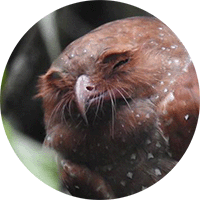Oilbird
| Order: CAPRIMULGIFORMES - Family: STEATORNITHIDAE |
| 1 Species currently existing - 1 in region |
The Oilbird (Steatornis caripensis). Read in Spanish
Appearance: The Oilbird is a large, nocturnal bird with a distinctive appearance. It has a stout body, large head, and long wings. The plumage of the Oilbird is mostly brown with black and white markings. It has a prominent hooked bill and large eyes adapted for night vision.
Habitat: Oilbirds are primarily found in tropical and subtropical forests with caves or other dark, secluded roosting sites. They often inhabit humid rainforests and feed on fruit found in the canopy of the trees.
Behavior: Oilbirds are nocturnal and spend their days roosting in dark caves or tunnels. They are excellent navigators and use echolocation - similar to bats - to find their way in the darkness. The Oilbird is known for its unique diet of fruit, particularly palm fruit, which it locates using its keen sense of smell.
Breeding: Oilbirds breed in colonies within caves, where they build nests high up on ledges or crevices in the cave walls. The female usually lays a single egg, which both parents take turns incubating. After hatching, the chick is cared for by both parents and fed regurgitated fruit pulp until it is ready to fledge.
Conservation Status: The Oilbird is considered a species of Least Concern according to the International Union for Conservation of Nature (IUCN).
Distribution
The Oilbird (Steatornis caripensis)
Andean Region: Oilbirds can be found in parts of the Andean region of Colombia, where they inhabit the lush montane forests. Particularly, they are known to occur in regions such as the Sierra Nevada de Santa Marta and the Andes Mountains.
Caribbean Region: In the Caribbean region of Colombia, Oilbirds have been reported in areas with suitable cave systems and forested habitats. This includes regions like the Sierra Nevada de Santa Marta and the coastal areas of the Caribbean.
Amazon Rainforest: Oilbirds are also found in some parts of the Colombian Amazon rainforest. They inhabit dense tropical rainforests with caves or natural cavities that serve as roosting sites for these nocturnal birds.
Pacífico Region: The Oilbird is less common in the Pacific region of Colombia, but they can still be found in some areas with suitable forested habitats and caves along the Pacific coast.
Taxonomy
The Oilbird (Steatornis caripensis)
- Kingdom: Animalia
- Phylum: Chordata
- Class: Aves (Birds)
- Order: Caprimulgiformes
- Family: Steatornithidae
- Genus: Steatornis
- Species: Steatornis caripensis
Vocalization
The Oilbird, also known as the Guácharo, is known for its unique vocalizations that are part of its communication and echolocation abilities. Here are some key aspects of the vocalization of the Oilbird:
- Echo-location Clicks: Oilbirds, like bats, use echo-location to navigate in the dark. They produce a series of sharp, clicking sounds that bounce off objects in their environment, helping them locate obstacles and find their way in their dark roosting sites such as caves.
- Calls: In addition to echo-location clicks, Oilbirds also produce various calls for communication. These calls can include guttural grunts, whistles, and chattering sounds. These vocalizations are used for mate attraction, territory defense, and maintaining contact with other members of their colony.
- Long-Distance Communication: Oilbirds are known to have loud and distinctive calls that can be heard over long distances in their forested habitats. These calls are important for social interactions among the birds and for coordinating activities within the colony.
- Breeding Calls: During the breeding season, Oilbirds may vocalize more frequently and intensely as part of courtship and mating rituals. These calls can vary in pitch and intensity depending on the context of the interaction between individuals.





